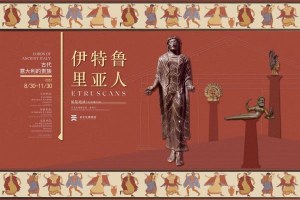The Etruscan civilization on display in China for the first time
The exhibition ETRUSCANS. Lords of Ancient Italy, one of the major initiatives presented in the frame of the 2022 Italy-China Year of Culture and Tourism, opened on August 30 at the Museum of Wu in Suzhou.
Conceived and curated by the Archaeological Civic Museum of Bologna, it is promoted by the Italian Cultural Institute in Shanghai in collaboration with the Consulate General of Italy in Shanghai and the organization of MondoMostre.
The great exhibition project will tell the refined Etruscan civilization – still almost completely unknown to the Chinese people – with 303 artifacts of the highest historical and artistic value from both the Archaeological Museum of Bologna historical collections and the findings discovered during the nineteenth-century excavations in Bologna and its territory, which are flanked by 27 finds belonging to the National Archaeological Museum of Naples.
The exhibition itinerary has five thematic sections which, starting from the composite world of pre-Roman Italy, draws attention to the Rasna – as the Etruscans called themselves – the people who, before Rome, dominated almost the entire Italian peninsula.
As a connection between the first introductory section and the fundamental part of the exhibition, an insight defines the geography of Etruria and describes its "political" and social structure in a simple way, also explaining the forms of production (crafts, agriculture, exploitation of mines, etc.) and exchange (trade and contacts with the Mediterranean, Asia Minor and transalpine Europe).
The heart of the exhibition analyses the main aspects of the Etruscan world daily life, illustrating – through the suggestion of the objects – the customs and activities of a woman and a man, whose representations welcome the visitor to accompany him into their own world.
The topics covered range from body ornamentation and care – through which not only a personal taste but above all the social level was expressed – to typically female (spinning and weaving) and male (war, hunting, politics, athletics) activities; from the collective forms of the consumption of food and drinks in the rituals of banquets and symposiums to the practice of writing derived from the Greek people and adapted in the alphabet to the needs of their language, up to the religious cult, which had a fundamental role in the Etruscan society since its beginnings.
The penultimate section of the exhibition shifts the focus from the world of the living to the hereafter, presenting reconstructions and finds that show the Etruscans’ beliefs, rituals, and ultramundane expectations.
The itinerary ends with a perfect copy of the situla of the Certosa, one of the most prestigious objects of the Archaeological Civic Museum of Bologna which, due to its importance and fragility, cannot travel. The vase is made of a single bronze leaf, decorated with embossed and engraved figured scenes. Like a modern illustrated strip, the scenes compose a story that traces the history of an Etruscan community of the late 7th-early 6th century B.C. in its essential themes: war, hunting, subsistence activities, the consumption of wine, music, with a reference to the scary and unknown hereafter world populated by ferocious creatures.
All materials are exhibited in China for the first time. After Suzhou, where it will run until November 30, the exhibition will make a second stage in Chengdu, the capital of the Chinese province of Sichuan.

